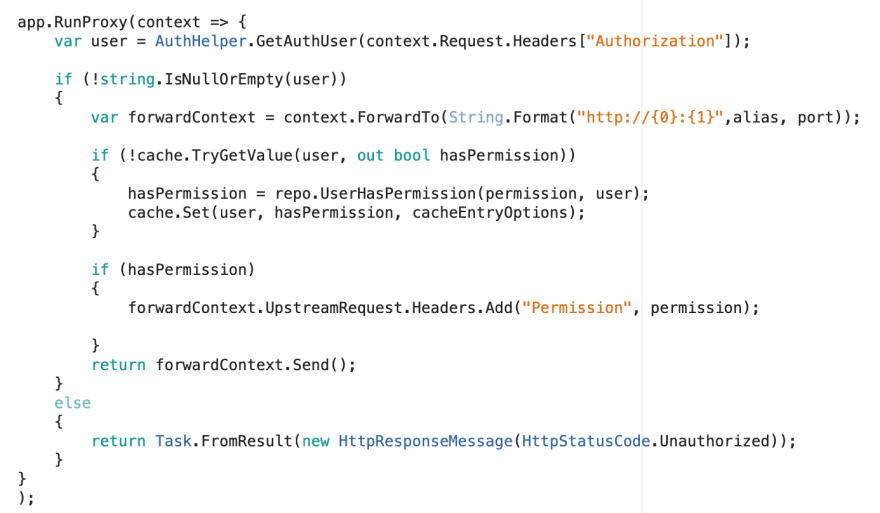This post looks at using a reusable, configurable, code-first proxy to provide a consistent, controllable and maintainable way to enrich web requests.
The problem
If often find myself in a situation where I need to run some organisation specific, but otherwise generic code at, or around, the API entrypoint to a service. There are a plethora of options for where you could perform this task, but each comes with its own challenges:
| Option | Distance from service | Challenge |
|---|---|---|
| Request Middleware | Same application | Tightly coupled to service - updates are HARD! |
| HTTP Filter | Same web server | Ties you to a web server - not really the done thing anymore |
| Sidecar | Same node | Large overhead to build and run |
| Service Mesh | Same node | Usually not great support for custom code |
| Reverse Proxy | Same logical system | Large overhead to build and run |
| Infra-first devices (Load balancer / API Gateway) |
Same organisation | Usually not great support for custom code |
A solution?
The solution that I will describe in this post could be used as either a sidecar or a reverse proxy, depending on your level of infrastructure abstraction.
The example system contains three components, the service, the proxy, and a database.
The code can be found here
I run all components locally using Docker for Mac. The Dockerfile for the proxy and the service are included in the repo. The containers are run on a user-defined bridge network, created by
docker network create mybridge
The proxy
For the proxy I envisioned a slim service that enabled a developer to slot in some custom functionality in the most straightforward manner possible.
Around this time Damian Hickey announced ProxyKit, which seemed to be exactly what I was after, so I set about creating a solution using it.
 Damian Hickey ❄️@randompunter
Damian Hickey ❄️@randompunter Looks like ProxyKit is a top trending C# project on github. It seems it fills a need.
Looks like ProxyKit is a top trending C# project on github. It seems it fills a need.
#unashamed-self-promotion14:48 PM - 06 Jan 2019
My proxy will look at the Authorization header for a user, look up information about the user in a datastore, and then add that information as a Header before forwarding the request to the downstream service.
This simple proxy is configurable in a number of ways -
- The 'alias' (ie. ip address, container name) and port of the downstream service
- The connection details for the database
- The information to retrieve from the database
- The amount of time to cache the data retrieved from the database
docker run -p 49161:80 -d \
--network=mybridge \
-e Downstream:Alias=api \
-e Downstream:Port=8080 \
-e Database:Host=postgres \
-e Database:Password=mysecretpassword \
-e Permission=HasSpecialPower \
-e CacheTimeSeconds=60 \
mattyjward/proxysidecar:blog
The database
For the database I used a fairly vanilla Postgres db, it just has a 'Users' table with some 'role' information.
docker run -p 5432:5432 -d -e POSTGRES_PASSWORD=mysecretpassword \
--network=mybridge \
--name=postgres \
--mount=type=volume,src=posgres,dst=/var/lib/postgresql/data \
postgres
The port is only exposed here so that I can connect directly to it and configure data - like so
psql postgres -h localhost -U postgres
and then
CREATE DATABASE Users;
\connect users
Create Table Users ( Name TEXT PRIMARY KEY, HasSpecialPower bool);
The service
For the service I created a simple Node app built on express. It looks for a header that the proxy sets, and uses it to make its authorization decision.
This does introduce some coupling between the proxy and the service.
docker run -d \
--network=mybridge \
--name=api \
mattyjward/permissionapi:blog
Run it
Once you have all three containers running, fire a request at your proxy server
curl -I localhost:49161 --header
Initially you should get a HTTP 401 Unauthorized response. This is being returned from the proxy service. When there is no Authorization header it will not even bother forwarding the request to the service.
So we'll add the header
curl -I localhost:49161 --header "Authorization:matt"
Now you should get a HTTP 403 Forbidden response. This is being returned by the service. The proxy could not find the user with the desired permission in the database, so did not add the header that the service is looking for.
Using psql, add a user to the database and give them the permission they need.
Insert into Users (Name, HasSpecialPower) Values ('matt', true);
Resend the previous curl http request (make sure you have waited for the cache to expire) and voila! you should get a HTTP 200. This is being returned by the service, after the proxy found the user with the permission in the database and added the header to the request.
What next
It would now be straightforward to spin up a second instance of the proxy which is appropriately configured for a different service.
This code is a fair way from production quality, but if I was to take it further I would look at
- replacing the Authorization header handling with proper OAuth JWT token validation
- using more complex authorisation policies
- using a container orchestrator








Top comments (0)